Focus Question: How does a capacitor store electric potential energy?
- A capactior is formed by two conductors seperated by an insulator. When a capacitor is connected to a battery, it quickly becomes charged, with the two plates taking on opposite charges. The net charge on a capacitor is zero since the plates have equal but opposite charges.
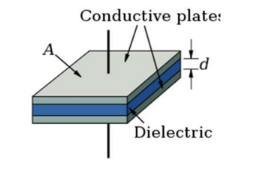
- Function of a capacitor – Stores electrical energy in the electric field between two plates.
- An electric field exists between the two conductors in a capacitor. The field and electric potential difference are proportional to the charge on the conductors.
$
C=\frac{Q}{V}
$
$Q$ – charge on each plate
V – potential difference units: Farads $(F)$
*A capactior always have zero net charge as the plates have equal but opposite charges. The charge in the equation for capacitance is the charge of each plate.
- Capacitor symbol:

Parallel Plate Capacitors
- Gauss’s Law can be used to find the electric field between the plates of the capacitor:
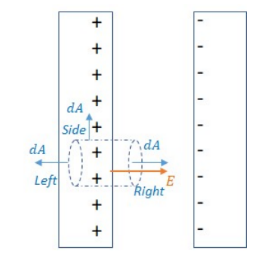
$\begin{aligned} & \emptyset=\oint \vec{E} \cdot \overrightarrow{d A}=\frac{Q_{e n c}}{\epsilon_0} \rightarrow E A=\frac{\sigma A}{\varepsilon_0} \\ & \rightarrow E=\frac{\sigma}{\varepsilon_0}\end{aligned}$
Relating E to other variabes: $V=E d \rightarrow \frac{Q}{C}=E d \rightarrow C=\frac{Q}{E d}$
$
\rightarrow C=\frac{Q}{\frac{\sigma}{\varepsilon_0} d} \rightarrow C=\frac{Q \varepsilon_0}{\frac{Q}{A} d} \rightarrow C=\varepsilon_0 \frac{A}{d}
$
Example A: The area of each plate in an air gap capacitor is $\mathrm{A} \mathrm{m}^2$. The capacitance of the capacitor is $\mathrm{C} \mathrm{F}$ and the electric field between the plates is $\mathrm{E} / \mathrm{m}$.
a) What is the potential difference across the plates?
b) How much charge is stored on each plate?
Answer/Explanation
a) $C=\varepsilon_0 \frac{A}{d} \rightarrow d=\frac{\varepsilon_0 A}{C} \rightarrow V=E d=E \frac{\varepsilon_0 A}{C} \rightarrow V=\frac{E \varepsilon_0 A}{C}$
b) $Q=C V \rightarrow C \frac{E \varepsilon_0 A}{C} \rightarrow Q=E \varepsilon_0 A$
- A charged capacitor is used to store electric energy. The amount of energy stored is equal to the work done to charge the capacitor.
- When charging a capacitor, charge is removed from one plate and added to the other. Work is required to transfer the charge:
A capacitor is charged by moving charge to a plate, which requires work. As a plate is charge to potential difference of $\mathrm{V}$, the charge on the plate goes from 0 to some charge $\mathrm{Q}$.
$
\begin{gathered}
d W=V d q \rightarrow d W=\frac{q}{C} d q \\
W=\int_0^Q \frac{q}{C} d q=\frac{1}{2} \frac{Q^2}{C}
\end{gathered}
$
The work done to charge the plate is equal to the energy stored on the plate”
$
U=\frac{1}{2} \frac{Q^2}{C}
$
Using $\mathrm{Q}=\mathrm{CV}$, the above equation can also be used to derive the more common form: $U=\frac{1}{2} C V^2$
- Energy per unit volume:
$
\text { Energy density }=\frac{U}{\text { Voume }}=\frac{\frac{1}{2} C V^2}{A d}=\frac{\frac{1}{2} \varepsilon_0 \frac{A}{d}(\boldsymbol{E d})^2}{A d}=\frac{1}{2} \varepsilon_0 \boldsymbol{E}^2
$
Example B: A capacitor is constructed of two large, identical parallel metal plates seperated by a small
distance d. A battery fully charges the capacitor and is then disconnected.
(a) While the battery is still connected, plate seperation is doubled. Describe the changes, if any, of the voltage across the capactior, the electric field between the plates, and the energy stored in the
capactior.
Answer/Explanation
Voltage – Since the battery is still connected, the voltage will not change.
Electric Field – The field will decrease. The capacitance is given by: $C=\varepsilon_0 \frac{A}{d}$, so when the plates get further apart, the capacitance decreases, which decreases the charge on the plates. Since the charge on the plate decreases, the electric field decreases.
Energy stored – By $U=\frac{1}{2} C V^2$, the energy stored on the plate decreases. Though the voltage stays the same, capacitance decreases. Less charge stored leads to less stored energy.
(b) The capacitor is disconnected from the battery, and the plate seperation is doubled. Describe the changes, if any, of the voltage across the capactior, the electric field between the plates, and the energy stored in the capactior.
Answer/Explanation
Voltage – The voltage will increase. The charge on each plate will stay the same, and the capacitor will decrease, so the voltage to increase since $\mathrm{V}=\mathrm{Q} / \mathrm{C}$.
Electric Field – The charge on each plate will stay the same. Since field is only based on charge density on the plates, the field stays the same.
Energy stored – By $U=\frac{1}{2} \frac{Q^2}{C}$, the energy increases in this case. The work done to separate the plates is transferred to the energy stored in the plates.
Capacitors in Parallel
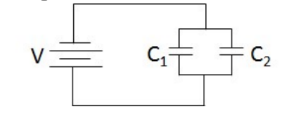
The capacitors are in parallel, so they have the same voltages, $V_1=V_2=V$. The charges add, $Q_{e q}=Q_1+Q_2$.
$
C_{e q} \forall=Q_1 \forall+Q_2 \forall
$
Capacitors in parallel act like a single capacitor whose capacitance is the sum of the capacitances.
$C_{e q}=C_1+C_2$
Capacitors in Series
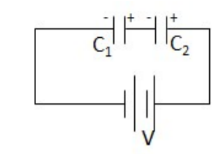
In series, a negative charge flows to $\mathrm{C}_1$ and a positive charge flows to $\mathrm{C}_2$. The region between the capacitors will remain neutral. In series, each capacitor stores the same amount of charge.
The voltages add: $V_{e q}=V_1+V_2 \rightarrow \frac{\theta}{C_{e q}}=\frac{\theta}{C_1}+\frac{Q}{C_2}$
Finding the equivalent capacitance of capacitors in series works the same as finding the equivalent resistance of resistors in parallel.
$\frac{1}{C_{e q}}=\frac{1}{C_1}+\frac{1}{C_2}$
Example C: Ponder the circuit on the right:
a) What is the equivalent capacitance of the network?
b) What is the potential difference across the 3 μF capacitor?
c) How much charge is stored in the 6 μF capacitor?
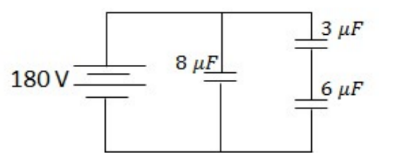
To find the equivalent capacitance, the equivalent circuit needs to be found:
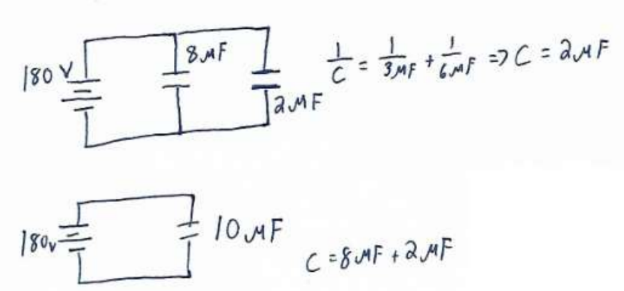
Answer/Explanation
a)10 μF
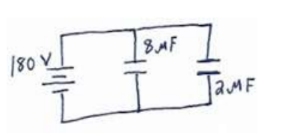
(b) In step 2 of the finding the equivalent circle, the charge on the $2 \mu F$ is the same as the charge on both the $3 \mu F$ and $6 \mu F$ capacitors since they are in series.
$
Q=C V=\left(2 \times 10^{-6} \mathrm{~F}\right)(180 \mathrm{~V})=3.6 \times 10^{-4} \mathrm{C}
$
The $3 \mu F$ capacitor thus has a charge of $3.6 \times 10^{-4} C$ stored:
$
V=\frac{Q}{C}=\frac{3.6 \times 10^{-4} C}{3 \times 10^{-6} \mathrm{~F}}=\mathbf{1 2 0} \mathrm{V}
$
(c) Since the $3 \mu F$ capacitor has $120 \mathrm{~V}$ across it, the $6 \mu F$ capacitor has $60 \mathrm{~V}$ across it since they must add to 180
$\mathrm{V}$.
$
U=\frac{1}{2} C V^2=\frac{1}{2}\left(6 \times 10^{-6} \mathrm{~F}\right)(60 \mathrm{~V})^2=.011 \mathrm{~J}
$
Example D: Find the capacitance of two concentric conducting cylinders of length $1.0 \mathrm{~m}$. The inner cylinder has radius $1.0 \mathrm{~mm}$ and the outer cyilnder has radius 2.0 $\mathrm{mm}$. The capacitors have equal but opposite charges of linear charge density $\lambda$. Cylindrical capatiors are much more common than parallel plate capacitors. To find the capacitance of a cylindrical capacitor using $\mathrm{C}=\mathrm{Q} / \mathrm{V}$, the voltage needs to be found based on the field.
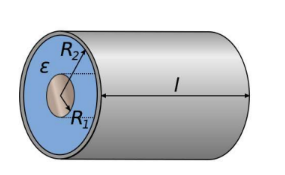
Answer/Explanation
Step 1: Found field in the region between the plates using Gauss’s Law.
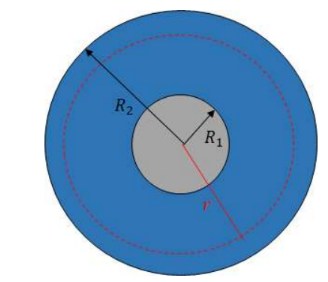
\begin{aligned}
& \emptyset=\oint \vec{E} \cdot \overrightarrow{d A}=\frac{Q_{e n c}}{\varepsilon_0} \\
& E(2 \pi r t)=\frac{\lambda t}{\varepsilon_0} \\
& \rightarrow E=\frac{\lambda}{2 \pi r \varepsilon_0}
\end{aligned}
Step 2: Find the potential using $V=-\int E \cdot d r$. The potential will be found based on going from the inner to outer plate.
$
\begin{aligned}
& V=-\int_{R_1}^{R_2} \frac{\lambda}{2 \pi r \varepsilon_0}=-\left(\frac{\lambda}{2 \pi \varepsilon_0} \ln |r|\right)\left|R_{R_1}^{R_2}=-\frac{\lambda}{2 \pi \varepsilon_0}\left(\ln \left|R_2\right|-\ln \left|R_1\right|\right)=-\frac{\lambda}{2 \pi \varepsilon_0} \ln \right| \frac{R_2}{R_1} \mid \\
& \rightarrow V=\frac{\lambda}{2 \pi \varepsilon_0} \ln \left|\frac{R_1}{R_2}\right|
\end{aligned}
$
Step 3: Find the capacitance using $\mathrm{C}=\mathrm{Q} / \mathrm{C}$
$
\begin{aligned}
& C=\frac{A L}{\frac{A}{2 \pi \varepsilon_0} \ln \left|\frac{R_1}{R_2}\right|} \\
& \rightarrow C=\frac{2 \pi \varepsilon_0 L}{\ln \left|\frac{R_1}{R_2}\right|}
\end{aligned}
$
Rate your understanding: Capacitors

- Most capacitors have a solid, nonconducting material between the plates. This material is called a dielectric.
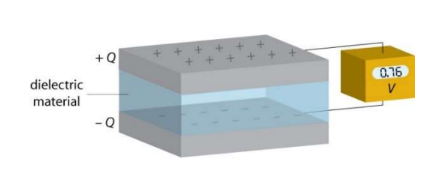
- Function of a dielectric:
- Keeps plates close, but not in contact
- Can tolerate greater field without dielectric breakdown
*Air is more suspect to dielectric breakdown, in which the insulator ionizes and charge can flow between the plates.
- Increases capacitance.
The potential difference between two charge plates decreases when a dielectric is used, but the charge on each plate stays the same. Electric field decreases when a dielectric is inserted, due to small induced charges appearing on the surfaces of the dielectric.
- The dielectric constant, κ:
$\kappa=\frac{C}{C_0}$
C-Capacitance with dielectric
$\mathrm{C}_0$ – Capacitance without dielectric $*_\kappa \geq 1$
Field Decreases: $\kappa=\frac{V_0}{V}=\frac{E_0 d}{E d}=\frac{E_0}{E}$
Permittivity increases: $\varepsilon=\kappa \varepsilon_0$
Voltage:
Case 1: If the battery is no longer connected, voltage decreases $\kappa=\frac{Q / V}{Q / V_0}=\frac{V_0}{V}$ *in this case, energy decreases due to the work done to insert dielectric.
Case 2: If the capacitor is still connected to the battery, voltage remains constant *In this case, energy increases since capacitor increases and voltage is constant.
Example A: A $275 \mu \mathrm{F}$ capacitor will be manufactured using a dielectric having a permittivity of $4.00 \varepsilon_0$ and circular plates having a diameter of $2.50 \mathrm{~cm}$. What should the plate separation (and the thickness of the dielectric) be? Is it likely that this large a capacity could be constructed using parallel plate architecture?
Answer/Explanation
$
\begin{aligned}
C & =\frac{\kappa \varepsilon_0 A}{d} \rightarrow d=\frac{\kappa \varepsilon_0 A}{C} \\
d & =\frac{4\left(8.85 \times 10^{-12} \frac{C^2}{N m^2}\right)\left(\pi\left(\frac{.025}{2} \mathrm{~m}\right)^2\right)}{275 \times 10^{-6} \mathrm{~F}}=6.3 \times 10^{-11} \mathrm{~m}
\end{aligned}
$
It would be extremely difficult to construct a plate separation this small.
- Electric field in a dielectric using Gauss’ Law:
*induced charges appear on the surface of the dielectric.
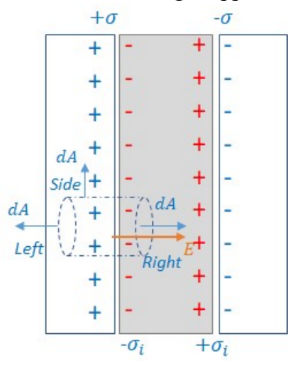
$\sigma:$ charge on plates $\quad \sigma_i:$ induced charge on dielectric surface
$
\begin{aligned}
& \emptyset=\oint \vec{E} \cdot \overrightarrow{d A}=\frac{Q_{e n c}}{\epsilon_0} \rightarrow E A=\frac{\left(\sigma-\sigma_i\right) A}{\varepsilon_0} \\
& \rightarrow E=\frac{\sigma-\sigma_i}{\varepsilon_0}
\end{aligned}
$
* Since the permittivity increases by a factor of $\kappa, \mathrm{E}$ is also $E=\frac{\sigma}{\kappa \varepsilon_0}$
Relationship between induced dielectric charge and dielectric constant:
$
\begin{aligned}
& \frac{\sigma-\sigma_i}{\varepsilon_{\forall}}=\frac{\sigma}{\kappa \varepsilon_\theta} \\
& \rightarrow \boldsymbol{\kappa}=\frac{\boldsymbol{\sigma}}{\boldsymbol{\sigma}-\boldsymbol{\sigma}_{\boldsymbol{i}}}
\end{aligned}
$
$\kappa=\frac{E_0}{E}$
- Energy density in dielectric
Density $=\frac{U}{\text { Volume }}=\frac{\frac{1}{2} \kappa C V^2}{A d}=\frac{\frac{1}{2} \kappa \varepsilon_0 \frac{A}{d} E^2 d^2}{A d}=\frac{1}{2} \kappa \varepsilon_0 E^2$
Example B: A parallel plate capacitor of area A and plate separation L is filled with a removable dielectric slab of dielectric slab constant κ. The capacitor is given a charge Q with the slab removed, is disconnected from the battery and then the slab is inserted.
a) Find the potential difference with and without the dielectric slab.
b) Find the electric field between the plates with and without the slab.
c) Find the induced charge on the slab.
Answer/Explanation
a) W/0 slab: $\quad V_0=\frac{Q}{C}=\frac{Q}{\varepsilon_0 \frac{A}{d}}=\frac{Q d}{\varepsilon_0 A}$ with slab: $K=\frac{V_0}{V} \Rightarrow V=\frac{V_0}{K}=\frac{Q d}{K \varepsilon_0 A}$
b) W/0 slab: $E_0=\frac{\sigma}{\varepsilon_0}=\frac{Q}{A \varepsilon_0}$ With slab: $K=\frac{E_0}{E} \Rightarrow E=\frac{Q}{K A \varepsilon_0}$
c)
$
\begin{aligned}
& K=\frac{\sigma}{\sigma-\sigma_i} \Rightarrow \sigma-\sigma_i=\frac{\sigma}{K} \Rightarrow \sigma_i=\sigma-\frac{\sigma}{K} \\
\Rightarrow & \sigma_i=\frac{Q}{A}-\frac{Q}{A K} \Rightarrow \sigma=\frac{Q K-Q}{A K}
\end{aligned}
$
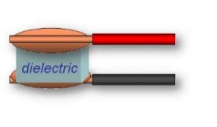
Example C: A capacitor having no dielectric has a capacitance of C. It is charged up to V by momentarily attaching it to a battery, and then disconnecting it.
a) What is the energy stored in the capacitor at this voltage?
b) What is the charge on the capacitor?
c) A dielectric having a permittivity of 20 is now carefully inserted between the plates of the capacitor.
What is its new capacitance?
d) What is the charge on the new capacitor?
e) What is the energy stored in the new capacitor?
f) Explain the discrepancy between (e) and (a).
Answer/Explanation
a) $U=\frac{1}{2} C V^2$
b) $Q=C V$
c) $\kappa=\frac{C^{\prime}}{C} \rightarrow C^{\prime}=\kappa C$
d) $Q=C^{\prime} V=\kappa C V$
*Inserting a dielectric increases the charge by a factor of kappa: $\kappa=\frac{Q}{Q_0}$
e) $U=\frac{1}{2} \frac{Q^2}{C}$ The charge and the capacitance both increase by a factor of the dielectric constant: $U=\frac{1}{2} \frac{(\kappa C V)^2}{\kappa C}=\frac{1}{2} \kappa C V^2$
f) The energy increased by a factor of the dielectric constant even though the circuit was not connected to power. The work done to insert the dielectric was converted to energy stored in the capacitor.
Rate your understanding: Dielectrics
